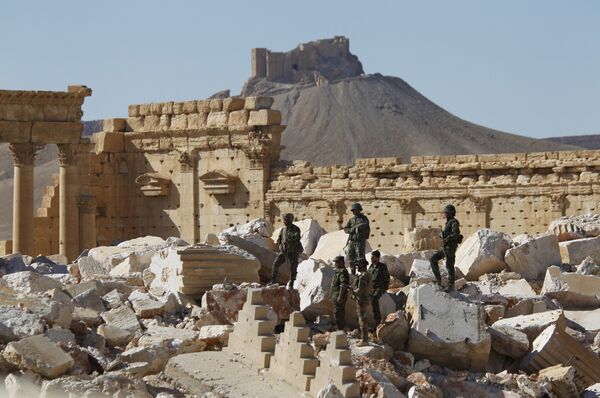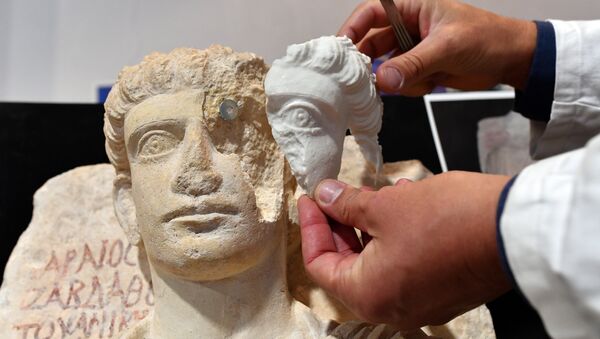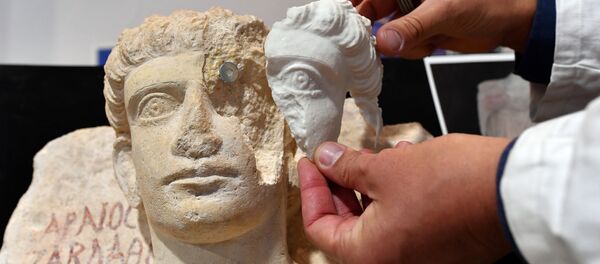Coordinator of the UN Analytical Support and Sanctions Monitoring Team concerning Daesh*, Al-Qaida** and Taliban, Edmund Fitton-Brown, shared his insights and expertise about the ways Daesh obtains its finances, about terrorists’ ties with organised crime, and about the nature of attacks in the future.
Sputnik: Is there any proven established link between radical jihadists, terrorists and organised crime? Is there an increasing number of cases when radical jihadists obtain arms from some organised criminal groups? Is the UN monitoring it and doing anything to prevent it?
Edmund Fitton-Brown: I will answer that question slightly in reverse. Certainly, the UN is very sensitive to this, and you'll be aware of the UN Security Council resolution 2482 which was passed in July during the Peruvian presidency of the Security Council. This was a very strong statement from the Security Council about the belief that there is a significant overlap between terrorism and organised crime and that member states need to make sure that their enforcement efforts are not hampered by unnecessary silo between the agencies who are tackling organised crime and the agencies who are tackling terrorism. So yes, definitely the UN is very serious about this, and. I would expect that this is also to some degree relevant to a slightly earlier resolution 2462 on terror finance, which again is about where do these groups get their finance from. In some cases, it will be from organised crime.
Now going to you first question, which is the extent of the overlap between terrorism and organised crime, I think it's a very complicated answer, but I think there are certain elements to it. The first question is do these groups themselves benefit by being able to recruit criminals as terrorists? The answer is definitely yes, there's no question about that. There is something that they call the redemption narrative. I've heard it expressed in one Daesh propaganda where they said “sometimes the best endings have the worst beginnings”, and what they're saying effectively is if you were a petty criminal, you know a thief or a drug dealer, whatever it is, but if you embrace Daesh, then everything can be forgiven, you can redeem yourself, you can have a respectable life and a respectable martyrdom. So, there's no doubt that that connection exists.

Secondly, are the terrorist groups at all choosy about using organised crime facilitation networks? The answer to that is definitely not. They are very happy to do that, and they do it all the time, and some Daesh terrorist finance movements have been through established money launderers who were money launderers dealing with non- terrorist funds but were perfectly happy in these cases to deal with terrorist funds as well. And the same applies to weapons, as you said. Certainly, again, criminal dealers in weapons will happen to supply terrorist groups many cases, while that may of course depend on the affiliation or the prejudices of that group. So if it's some group that is very anti-Daesh, they may not be willing to do it, but if you're talking about people who are moving weapons between Libya and sub-Saharan West Africa, then there's no such reluctance, and certainly there's a lot of that sort of criminal movement of weapons between Libya and Nigeria and other parts of sub-Saharan West Africa.
As we know, the Taliban derives a significant portion of its earnings from heroin, from poppy, and now the Taliban is not defined as a terrorist group, but it's a good example of where the principles of a jihadi group appear to be set aside in favour of the practicalities of being able to make large amounts of money as sort of the end justifies the means.
My final point on this would be just to say that I think a lot depends on the needs of the terrorist group. So if the terrorist group is trying to fund an insurgency, then they're going to need industrial scale resource. A good example obviously was Daesh itself - the caliphate was obviously heavily reliant on illicit oil sales and illicit sales of antiquities and cultural goods. You can say that the whole thing was a gigantic organised crime enterprise at one level. Whereas a small terrorist cell that has very limited objectives, maybe only the requirement to be able to hire a car to drive into a crowd, or to buy a knife to attack somebody in the street, they have no need of support from organised crime, and therefore it's highly unlikely that they would want to complicate whatever operation they were planning by the risk of contacting people who were already under investigation. Of course, the same applies to organised criminals, particularly the ones who are successful in making a profit. Why would they want to bring down the attention of the world's counter-terrorism authorities upon them, as well as the attention of the police and the Serious Organised Crime authorities. So, there are a number of things which limit the extent of the overlap between terrorism and organised crime. Nevertheless, there is an overlap.
Sputnik: According to your estimates, how much money do IS have at its disposal and where does it invest this money - geographically and also in which sectors of economy, businesses? Do you have information on the percentage – in which businesses is it mostly invested? Is it possible to track this money?
Edmund Fitton-Brown: We regularly quote the figure for the total financial reserves available to Daesh as between $50 and $300 million, which is a very wide range but it reflects the fact that there is a lot of international uncertainty in this subject, and I think it is fair to say that in terms of the international intelligence gaps, I think this is one of the biggest, which is a really accurate picture of Daesh finances. So when anyone talks about this, one is talking in quite approximate terms. Nevertheless, I can say certain things about this. Some of the money is hidden in what they call cash, maybe a million dollars at a time, in certain physical hiding places – buried or that sort of hiding place, and some of those are picked up on sporadic basis by the authorities, and certainly the Iraqis have had some successes with finding caches of money. Some of this is in the form of cash or in the form of gold, and still in the core area. But you're absolutely right that some money has definitely been invested in businesses. And these businesses will be in many cases legal businesses. Not all of them will be in Iraq and Syria. Some of them may be in the neighborhood or some of them may even be further afield.
In terms of what kind of businesses, we know that there is some investment in real estate, and that includes phones, fisheries, boarding houses and properties. Obviously one of the concerns with that is that whether it's land or buildings on land or apartments, that is a concern because it represents not just an investment but also a facility. One would obviously be concerned about what might be kept or who might be kept in locations of that kind. We understand there were also some investments in the automobile and automotive sector, and of course it's also important to remember that there is some overlap here with certain types of organized criminality, and that certainly includes some of the legacy trade in looted antiquities and cultural artifacts. Of course, one of the questions that we cannot answer, about which I think at the time the answer will emerge more and more in detail, is just how much was stolen in terms of antiquities and cultural goods.
Some of it of course came out of digs which were licensed by Daesh when they had that power, and that means that some of the antiquities are things that people don't even know are missing, as opposed to where museums have been looted when at least we know what has been taken. With the digs, you don't know what's been taken. This is one of those interesting subjects where the picture of it seems to grow as time goes by, and if you think about it that makes sense because a lot of these things cannot be sold until enough time has passed for a credible transaction history to be created for them. So, I think we don't know the size of this problem but I suspect it's quite a big problem. And of course, there are some cultural artifacts that could be “low volume high value.” It's possible that those could be in caches that could be hidden somewhere and could be therefore assets which ISIL still have directly at their own disposal with of course a lot of the other artifacts that would have been sold on and will presumably no longer be in Daesh’s hands.
Sputnik: Are any of these legal businesses, in which IS might have invested money, located in Europe?
Edmund Fitton-Brown: I don't have direct evidence of that. I think I would say that very likely yes. But I'm saying purely on the basis of the fact that ISIL has sought to diversify and put its money in various places where it will be accessible for future use, and as I said that includes the core area, that includes the immediate neighbourhood, but I think it also includes further afield, and therefore Europe is possible.
Sputnik: And talking about future, future, in your opinion, what will the “new generation” of terrorist attacks look like? How is their nature changing? What dangers does the 5G network bear in terms of the potential of being used and accessed by terrorists?
Edmund Fitton-Brown: There's a lot of work that the UN does and sponsors on the implications of new technologies for terrorism. Some of these will be communications-related, as you've already mentioned. Some of them might be to do with computer-type distribution attacks - you could, for example, attack some aspect of a country's critical national infrastructure through weaknesses in its cybersecurity. You could also have finance of terrorist groups using new financial technologies, such as cryptocurrencies. These are all definitely issues which people need to take seriously, and they are issues which countries do monitor and academics also monitor, and the UN does a certain amount of convening of these kinds of groups that look at these issues. But there are two points that I would like to make on this. One is that terrorist groups will not overcomplicate if they think they can achieve things in its simplicity.
So, if they think they can move money using a suitcase full of money and a cash courier and a corrupt border guard, they'll do it. Then it doesn't really matter about raising money using cryptocurrencies. And the same goes for certain types of attack. I mean, Daesh would not be happy indefinitely to rely on bladed attacks, because there's only so much damage that one person with a knife could do. But when you look at the extent of casualties which a vehicle can create, in particular a large vehicle like a truck or a lorry, you can see that that's a sort of a “low technology - mass casualty” option. We haven't seen much in the way of terrorists using arson, but again fire represents a “low technology - mass casualty” option.
Maybe this also explains why we haven't seen very much in the way of the use of weapons of mass destruction, because those are often complicated and dangerous to use, and therefore from the terrorist group's point of view it may be preferable to use other, less complicated and less dangerous options. Nevertheless, we mustn't forget that the WMD issue is still present. ISIL had a programme while they had the so-called caliphate.
So my answer is to say that sooner or later I'm sure we will see some highly innovative attack, using either a completely unexpected type of target or some kind of new technology, but I think that the logic of cost and survival is that where they can use traditional methods against traditional targets, they will continue to do so.
The Monitoring Team is subordinate to the Security Council and to the committees that deal with IS (banned in Russia), al-Qaida and the Taliban. Two main functions of the Team are providing a threat assessment report on the three groupings, and maintenance of the sanctions, as well as advising UN member states to add or remove individuals or entities from the sanctions list.
* Daesh (ISIL/ISIS/IS/Islamic State) is a terrorist organisation banned in Russia
** al-Qaeda is a terrorist organisation banned in Russia





